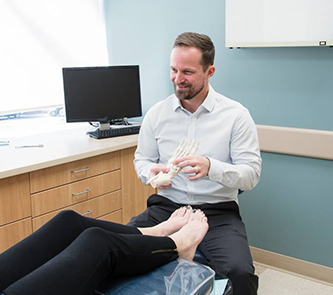I Think I Have Flat Feet
“I think I have flatfeet…” is a concern I hear from patients daily. Half of them are correct, half of them are not, but none of them know the biomechanical issues and potential dangers that can occur in the flat foot.
What is a flat foot?
A flat foot is a specific foot type that has a collapsed arch. Some the most common descriptions from patients of this foot type are “out-toeing,” instability while standing or walking, feet slapping the ground during ambulation, fatigued leg muscles, and last but not least “ankles rolling inward.” In more scholastic terms, a pes planovalgus foot type has a collapsed medial longitudinal arch with midtarsal abduction. This means the forefoot will point outwards and the inside of the ankle will roll inward.
How did I get flat feet?
Having flat feet relies heavily on genetics. Many patients can relate having flat feet to someone in their family, and this is very common and normal. The overall biomechanical structure of our feet is expressed through our genetic make up, and there is nothing that can be done to prevent it.
What do flat feet cause?
Due to instability at multiple different points along the kinetic chain, flatfeet can cause a multitude of painful symptoms. In fact, close to, if not more than half of the diagnoses treated in our clinical setting can be related to, or directly caused by pes planovalgus. Listed below are just some of the most common diagnoses:
- Plantar Fasciitis
- Achilles Tendinitis
- Sinus Tarsi Syndrome
- Posterior Tibial Tendinitis
- Hallux Abductovalgus (Bunions)
- Hammertoes
Do I need to do anything about my flat feet?
If you read the last paragraph and felt that you might have any of the above diagnoses, some simple readjusting with a prefabricated or custom orthotics will probably take care of any symptoms you’re having. If you feel that you have flat feet and do not have any painful symptoms, then nothing needs to be addressed (if it ain’t broke, don’t fix it). Listed below are some easy things to do to prevent (or delay) any flat foot related pathology from occurring:
- Avoid walking barefoot – walking barefoot increases the stress on multiple joints and tendons that already have to work harder to hold the foot in a better position
- Avoid “free” soles and flat, unsupportive shoes and sandals – wearing unsupportive shoes is akin to walking barefoot. Wearing stiff soled, supportive shoes with a good arch will help to hold your feet in a better position and prevent added stress from occurring
- Give your feet a rest!
Pay Your Bill
Make a payment online through our payment portal or Care Credit!
Portsmouth Office
14 Manchester Square, Suite 250
Portsmouth, NH 03801
Nashua Office
17 Riverside Street, Suite 205
Nashua, NH 03062
Website Hosted by SC Digital



